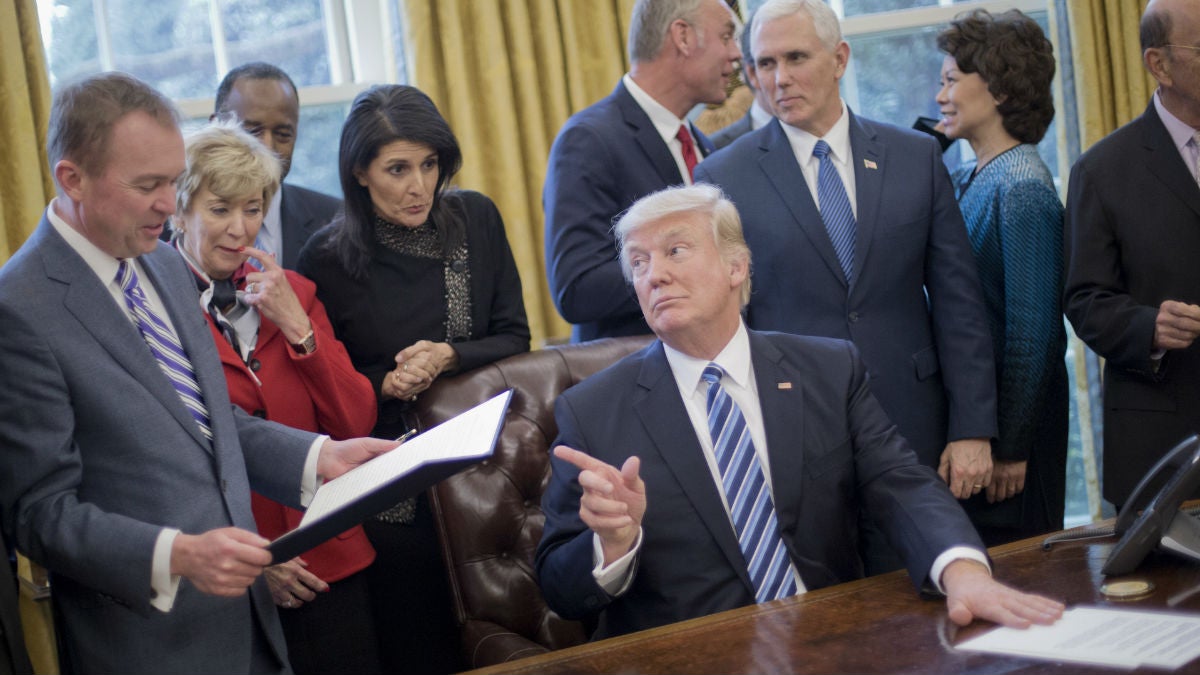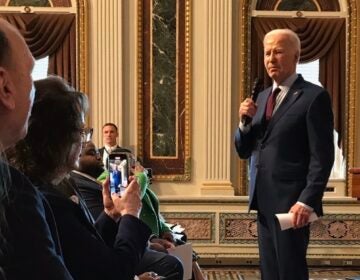Delaware leaders decry Trump’s proposed cuts in funding arts, education, and housing
Listen
President Donald Trump looks over towards Budget Director Mick Mulvaney, left, after signing an executive order in the Oval Office of the White House in Washington, Monday, March 13, 2017. (AP Photo/Pablo Martinez Monsivais)
From after school programs to arts funding, President Trump’s proposed federal budget cuts are facing fierce opposition in Delaware.
Delaware House Majority leader Valerie Longhurst, a champion of after-school learning and enrichment programs, said Friday she was stunned by President Trump’s proposal to slash funding for such initiatives nationwide.
“There’s 2,700 [Delaware] kids in after-school programs and most are them are from high-poverty households,” the Democrat from Bear said. “Now they will have nowhere to go after school, nowhere to get educational help. We’re trying to close the achievement gap and that’s going to just make that bigger.”
Longhurst, who recently commissioned a report that called for an expansion of programs in Delaware, said the state currently gets $5.7 million a year in federal money to help launch programs. Without that money, “It’s going to set us back,” she bemoaned.
Longhurts’s concerns and others were voiced by various leaders in Delaware education in the wake of the president’s budget blueprint, which would cut Department of Education funding by 13 percent, from $68 billion to $59 billion.
Susan Bunting, Delaware’s education secretary, was not available for an interview. But her spokeswoman, Alison May, issued a statement that said the proposed cuts, if enacted, “could have a significant impact on Delaware students and educators.”
Delaware would lose about $10 million from a program that helps the state pay for “things such as teacher salaries and professional learning for educators,” May said. Losing the money for after-school and community programs would hurt the state’s ability to “provide academic, artistic, and cultural enrichment opportunities to low-income students and their families during non-school hours.”
Trump’s proposal, unveiled Thursday and entitled “America First: A Blueprint to Make America Great Again”, said the president’s spending plan for education “places power in the hands of parents and families to choose schools that are best for their children.”
The White House added that the proposal “continues support for the nation’s most vulnerable populations, such as students with disabilities” and “protects support for historically black colleges and universities” such as Delaware State University in Dover.
To that end, the proposal would pour $20 billion into public and private school choice programs — a $1.4 billion increase — and keeps about $13 billion to help children with special education needs. It would keep $492 million that helps maintain post-secondary “programs that serve high percentages of minority students.”
The administration said it aims to “support these investments and carry out its core mission while lowering costs to the taxpayer by reducing or eliminating funding for programs that are not effective, that duplicate other efforts, or that do not serve national needs.”
Among those on Trump’s chopping block is the 21st Century Community Learning Centers initative, which supports before- and after-school and summer programs. The program, which cost $1.2 billion this year, “lacks strong evidence of meeting its objectives, such as improving student achievement,” the blueprint said.
Rep. Longhurst said studies have shown a strong link between such programs and improvement in student achievement.
Trump’s “lack of curiosity in understanding the benefits of after-school programs just blows my mind,” Longhurst said. “I’m hoping Congress will get it. I think they do. I’m upset but I’m going to remain optimistic.”
Frederika Jenner, president of the Delaware State Education Association, the labor union that represents teachers and most other public school employees, said Trump’s proposal “will impact our most vulnerable students in Delaware and across the country.”
Children living in poverty, learning to speak English or with special disabilities or needs would suffer, Jenner said.
“This is extremely concerning as it has been our goal for a long time to increase resources in those categories,” Jenner said.
Jenner said the proposal would cut funding for programs that provide specialized training for teachers in low-income schools and those who instruct children with disabilities. Such cuts would also increase class sizes, she said.
During a time when Gov. John Carney and lawmakers must find ways to erase an anticipated $350 million deficit for fiscal 2018 and many of the state’s 19 school districts are “struggling economically,” cuts in education by the federal government “puts more of a burden” on Delaware, Jenner said.
Delaware spends one-third of its general fund budget on public education.
Jenner also said the increase in federal funding to help parents send their children to the public or private school of their choice means “a voucher program” for families who might decide to use the money for a religious school.
“We are very concerned about sending kids to religious schools with taxpayer money,” she said. “We do believe in upholding the separation of church and state.”
Carlos Holmes, spokesman for Delaware State University, said school officials “are pleased” Trump wants to maintain funding levels for historically black and minority-serving institutions as well as the Pell Grant program for financially needy students.
School officials aren’t so pleased with proposed “significant reductions” to the Work-Study program but believe their students can still benefit from the money that remains, Holmes said. As for the planned elimination of Supplemental Educational Opportunity Grants, Delaware State leaders hope negotiations with Congress can restore at least some of the $732 million allocated in 2017.
Arts cuts would affect everyone
In 2016, Delaware’s share of the federal budget supporting the arts was $693,000. Under Trump’s proposed budget that number would become $0.
According to the Washington Post, in 2016 funding for the arts totaled $3.899 trillion, or .02% of the federal budget. Delaware’s share of that funding makes up about 16 percent of the budget for the Delaware Division of the Arts. The impact of losing that money would be felt throughout the state, according to Division Director Paul Weagraff.
The Delaware Division of the Arts provides programs and services to the general public, as well as providing grants to arts organizations. Those organizations serve more than a million Delawareans.
Proposing these kinds of cuts isn’t a new problem. “What is new this year is that proposal has come at the beginning of the process from the White House,” Weagraff said.
The National Endowment for the Arts isn’t the only group being targeted by these cuts. The budget proposal would also eliminate funding the National Institute of Museums and Library Services, the National Endowment for the Humanities and the Corporation for Public Broadcasting, of which WHYY and by extension NewsWorks.org, is a member station and beneficiary of this funding.
Historically, these organizations have received bipartisan support and attempts to reduce their funding have been met with resistance.
The Delaware Congressional delegation has always been supportive of the arts in Delaware. “They recognize the value that the arts have in the economic vitality of our communities, in the educational life of our youth and in the quality of life on our communities,” Weagraff said.
Art is not just limited to paintings hanging in galleries in museums. According to Weagraff, these programs are vital to attracting “businesses, residents and tourists.”
The impact of the arts can also be felt on Delaware’s bottom line. “For every $3 invested through public dollars there’s a $9 return at the state and local level in tax revenue,” Weagraff said.
The impact of these proposed cuts won’t be known until the budget is passed in whatever form it takes but the impact may be felt in places you didn’t realize it would. “I can tell you not knowing what the scale of the cutback would be, it’s hard to say what the scale of the impact would be,” Weagraff said. Some of the programs that would be impacted include art therapy programs for adults with disabilities, after school arts programs for youths, reading readiness programs for pre-school children, artist’s residencies in Delaware’s schools, and grants to Delaware’s arts organizations. Those grants provide programming from community theatres and professional opera companies to major visual arts organizations and museums.
The effect would also be felt in Delaware’s schools. The arts are a part of the core curriculum. Weagraff said, “We require that [the arts] be offered to all students from K-12 and its critical to the well-rounded learning of students.”
In fact, students all over the state not just in the most affluent districts benefit from this funding. “We as a state agency insure that support for the arts reaches all corners of the state,” Weagraff said.
Public agencies like the Delaware Division of the Arts and the National Endowment for the Arts, “Have a mandate that that public funding is dispersed broadly to reach all communities and that’s not the case with a lot of private funders.”
Furthermore, Weagraff believes “the public funding for the arts is critical for ensuring that all Americans have access to arts programing.” That support also makes it to Delaware’s libraries, many of which serve communities where an arts organization doesn’t exist. In some instances, these programs are the only means by which many of Delaware’s youth may gain access to the arts. “Part of our mandate is to use delivery mechanisms that transcend the geographic restrictions of the arts organizations themselves.”
For Weagraff, the best case going forward, “is that the national endowment for the arts is at least retained at its current level.” He urged anyone who believes in the importance of the arts for their children or grandchildren to speak up.
“The most important role people who believe in the arts can play, is to reach out to their legislatures and speak up on behalf of the importance of the arts in their lives.”
“Disregard for the real concerns of families”
Delaware’s senior U.S. Sen. Tom Carper, D- Delaware, said President Trump’s budget “is in no way a serious policy proposal.” He went on to call it an “irresponsible, political statement that, if ever enacted, would make our country less safe, put Americans’ health and safety at risk and leave the most vulnerable among us in dire straits.”
Carper’s criticism of the budget proposal focused on the health consequences Americans could face if funding for Environmental Protection Agency programs was cut by 31 percent. “These cuts would cripple states’ ability to carry out even the most basic protections, like ensuring communities have safe water to drink,” Carper said in a statement.
Carper was also critical of Trump’s plans to cut funding for the Army Corps of Engineers by 17 percent.
“These cuts make clear that President Trump lacks even a basic understanding of the critical role these agencies play and show his disregard for the real concerns of families across this country.”
Cuts in housing funds
Leaders of the Delaware State Housing Authority are still digging into the Trump budget to determine what a $6 billion cut to Housing and Urban Development would mean to the agency. And while they weren’t available to comment directly on the impact of Trump’s proposed cuts, they did offer lots of background on exactly what money the agency gets from HUD.
While DSHA gets significant funding from HUD, but other HUD funding also goes to public housing authorities in Wilmington, Newark, Dover and New Castle County.
In FY17, DSHA received $4.5 million from HUD for public housing. That helped operate 10 sites with a total of 508 housing units. Residents at those sites have an average income of $16,400, while 60 percent of residents are elderly or disabled. There are 344 families living at those locations that have children under 18.
DSHA also administered $7.4 million in Housing Choice Vouchers (formerly known as Section 8) in FY17. That money helped more than 900 families with an average income of just $14,077. Of those voucher recipients, 78 percent are elderly or disabled and 370 have children under 18.
While it’s not exactly clear what if any of those funds would be cut, DSHA staff are reviewing the details of Trump’s budget plans for HUD and are assessing the impact.
WHYY is your source for fact-based, in-depth journalism and information. As a nonprofit organization, we rely on financial support from readers like you. Please give today.




